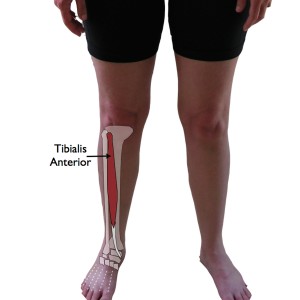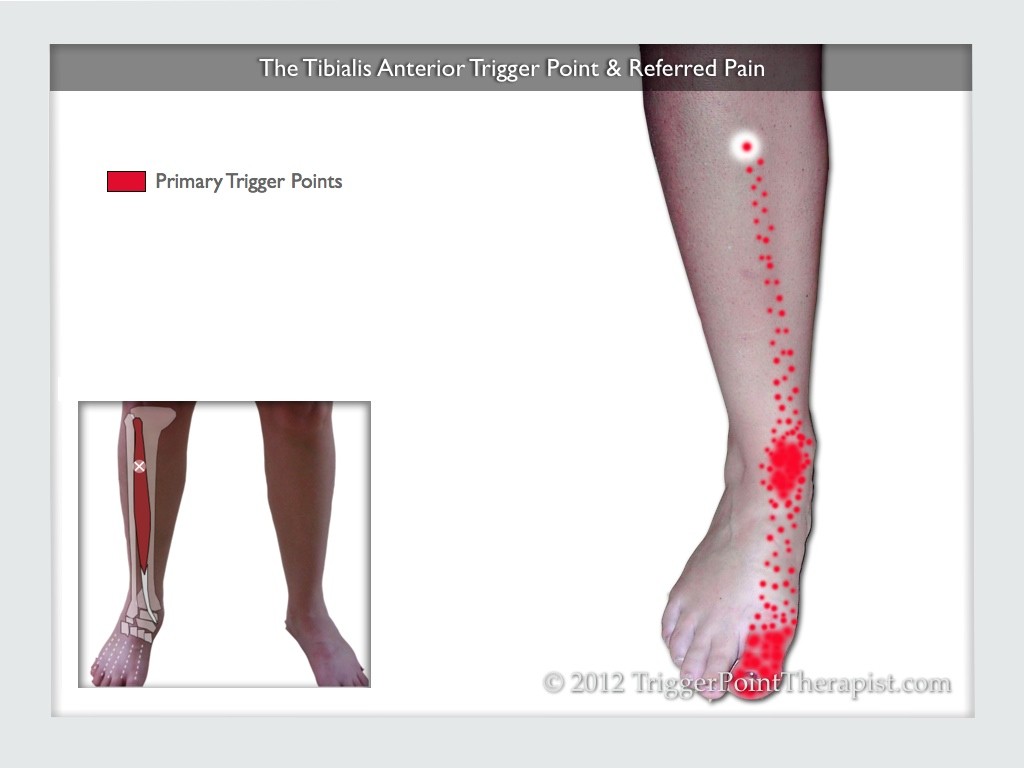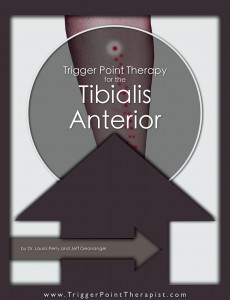This is one of those trigger points that, once you learn about it, you start seeing it everywhere. For example, my husband noticed that one of the NBA basketball players on the team he follows was out for several months with “foot drop” in one of his legs. The player probably had a more serious condition called Anterior Compartment Syndrome that affected his peroneal nerve function, but I guarantee you that a tibialis anterior trigger point played a huge role in his condition. And the fact that he was out for months and not weeks, probably means this trigger point was never clinically addressed. That is frustrating for a trigger point therapist to see!
 The tibialis anterior trigger point causes pain in the front of the ankle and on the big toe. The pain in the big toe can be mistaken for gout, and the metabolic condition that causes gout may also irritate the trigger points in the lower leg muscles. But most cases that I see are not in people who suffer from gout, they are in the “weekend warrior” people who push their bodies just a little too far.
The tibialis anterior trigger point causes pain in the front of the ankle and on the big toe. The pain in the big toe can be mistaken for gout, and the metabolic condition that causes gout may also irritate the trigger points in the lower leg muscles. But most cases that I see are not in people who suffer from gout, they are in the “weekend warrior” people who push their bodies just a little too far.
This trigger point weakens the tibialis anterior muscle which is responsible for raising (and lowering) the foot at the ankle as you walk. So when someone with this trigger point tries to take a normal step, their foot kind of drags behind and then slaps down after their heel strikes the ground. This is called foot drop and foot slap, respectively. Release the trigger point in this muscle and the foot drop goes away, though it may take a couple treatments and some time for the muscle to strengthen in chronic cases.
The Tibialis Anterior Muscle
Location: The tibialis anterior muscle lies just under the skin in the shin region of the lower leg. It is located just lateral to the boney edge of the Tibia in the upper half of the shin region.
Function: The tibialis anterior primarily functions to prevent foot slap after the hell-strike phase of walking by performing an eccentric (lengthening) contraction. It also contracts to help pull the leg and body forward over the planted foot during walking and running.
Muscle Structure: This muscle originates just under the knee cap on the lateral condyle of the tibia, and along the lateral edge of the upper half of the tibia bone. It runs down the front of the lower leg forming a tendon that passes around in front of the inside ankle bone and into the arch of the foot, attaching to the medial cuneiform bone and the first metatarsal bone.
Muscle Actions: The tibialis anterior acts to dorsiflex (raise) the foot at the ankle. When the foot is hanging free, contraction of this muscle also produces inversion (sole of the foot turns inward) and adduction (toes point inward) of the foot. The inversion of the foot produced by this muscle only occurs when the foot is dangling, not when it is planted and bearing the body’s weight.
Synergistic Muscle Groups: The following muscle groups share common biomechanical functionality with the tibialis anterior and may become overloaded if it’s unable to perform its workload due to trigger point activity or injury:
- The toe extensors (extensor digitorum longus and extensor hallicus longus) assist the tibialis anterior in dorsiflexion of the foot.
- The peroneus tertius muscle also assists with dorsiflexion of the foot.
- The tibialis posterior assists with inversion of the foot.
Antagonistic Muscle Groups: The following muscle groups act to oppose the movements produced by the tibialis anterior and may develop trigger point activity in response to neurological dysfunction or weakness in the tibialis anterior muscle.
- The gastrocnemius, soleus, and tibialis posterior are plantar flexors (pushing down) of the foot and are the primary muscles that oppose the dorsiflexion of the tibialis anterior.
- The peroneus longus and peroneus brevis produce eversion (sole turning slightly outward) of the foot and oppose the inversion of the foot produced by the tibialis anterior.
The Tibialis Anterior Trigger Point
The tibialis anterior trigger point can be found in the upper portion of the muscle belly, just a few inches below its insertion in the lateral tibia condyle.
Tibialis Anterior Pain
As show in the diagram above, this trigger point refers pain strongly to the front and inside of the ankle, and also to the top and inside of the big toe. Spillover pain may also occur in the shin and along the top of the foot if the trigger point activity is intense enough.
Tibialis Anterior Symptoms & Findings
Clients with an active tibialis anterior trigger point will present with any or all of the following symptoms or clinical findings:
- Pain and tenderness on the front and inside aspect of the ankle.
- Pain and tenderness on the top and inside surface of the big toe.
- Foot drop: clients will find it difficult to lift the foot as they take a step and will drag it across the ground, causing them to trip or fall.
- Foot slap: the client’s foot may slap down (uncontrolled) immediately after heel strike during walking.
- General weakness and painful motion in the ankle, without any history of ankle injury.
- Typically does not produce pain at night, but may if the foot is kept in a plantar flexed (down) position during sleeping.
- Muscle Weakness Test: With the client laying face-up on the table, the therapist inverts (turns the sole inward) the affected foot and then asks the client to try to lift (dorsiflex) the foot against a gentle resistance applied by the therapist. Make sure the client doesn’t compensate for weakness in the tibialis anterior by using their toe extensor muscles, which would be evident by them lifting (extending) their big toe as they try to lift their foot.
What Causes the Tibialis Anterior Trigger Point?
The following events or activities may activate or reactivate the tibialis anterior trigger point:
- Physical trauma to the shin, like being kicked in the shin or hitting it on a coffee table, is a frequent cause of trigger point formation in this muscle.
- Walking or hiking on rough or uneven ground for a long period of time can overload this muscle.
- Catching a toe on a step as you lift the foot to walk up a stair, or tripping over an unseen object while walking, can easily overload this muscle and initiate trigger point activity in it.
- Walking long distances in sandals or flip-flops can overload this muscle.
Related Disorders
- Big Toe Extensor Trigger Point: Referred pain from the trigger point in the extensor hallicus longus muscle concentrates on the top of the foot between the ankle and big toe (over the head of the first metatarsal bone) , but may also spillover into the front of the ankle and top of the big toe (resembling the referred pain from the tibialis anterior trigger point).
- Toe Extensor Trigger Points: Referred pain from trigger points in the toe extensor muscles (extensor digitorum longus and brevis) is also projected to the top of the foot but is found more laterally on the top of the foot than the referred pain from the tibialis anterior.
- Peroneus Tertius Trigger Point: The trigger point in the peroneus tertius muscle also refers pain to the front of the ankle but it can be distinguished from tibialis anterior referred pain by the fact that it doesn’t refer pain to the big toe.
- Anterior Compartment Syndrome: A serious disorder that can result from trauma to the shin region, overuse, or muscle tearing that is characterized by pain and swelling in the front of the leg that compromises the local circulation. Increased pressure in the anterior tibial compartment of the lower leg can result in necrosis (tissue death) of the muscles and nerves if not surgically addressed in a timely manner. Suspected cases of this condition should be referred out to test for increased pressure in the anterior compartment of the lower leg.
- Shin Splits: This condition is usually described as a chronic pain along the front and/or inside of the lower leg that is related to over-exercise. It is thought to be caused by inflammation of the outside layer of the tibia bone where the soleus muscle attaches to it, though it can occur where other muscles attach to the tibia bone too.
- Tibialis Anterior Muscle Herniation: This rare condition occurs when the tibialis anterior muscle ruptures the anterior compartment of the lower leg. It can be confirmed with an MRI study of the lower leg.
Treatment of the Tibialis Anterior Trigger Point
Locating and releasing this trigger point is super simple. For complete step-by-step instructions for treating this trigger point please purchase the Trigger Point Therapy for Tibialis Anterior Video + PDF Booklet.
Watch a sample from the Tibialis Anterior Trigger Point video on YouTube by clicking on the video image below:
Related Articles:
Related Instructional Videos :




